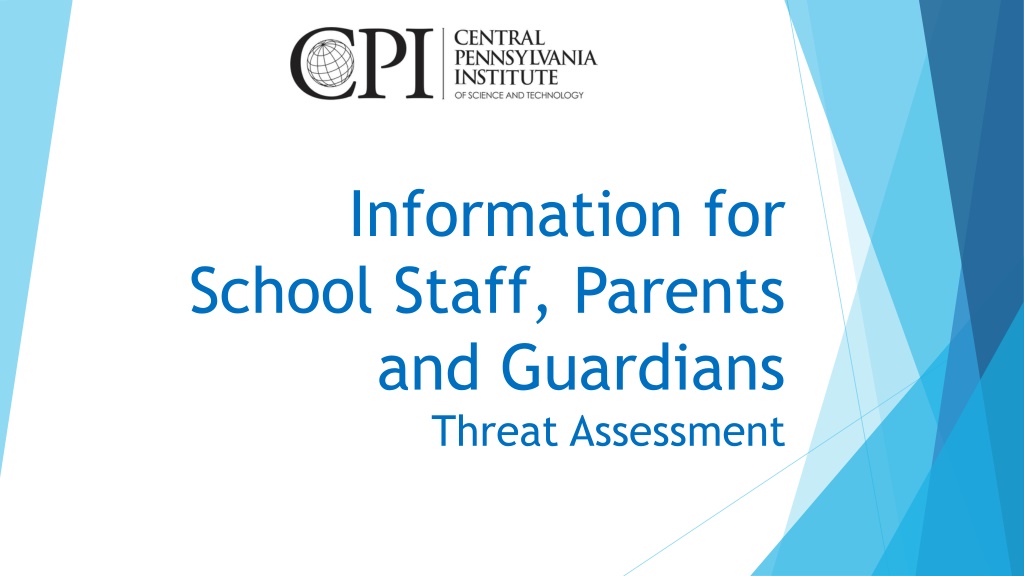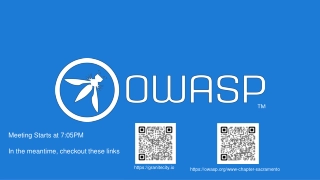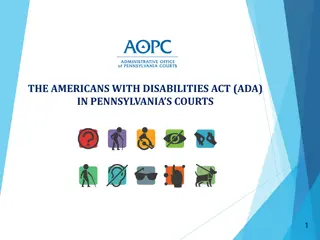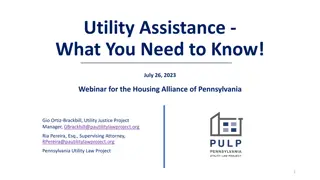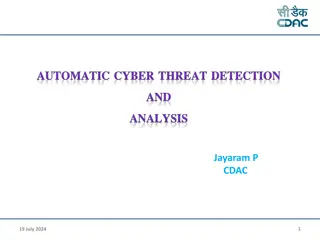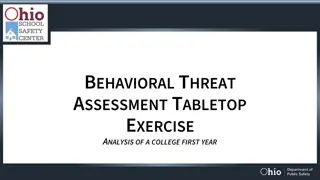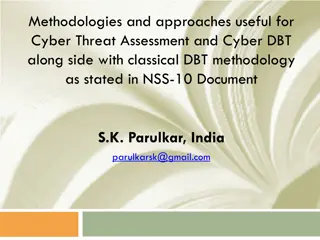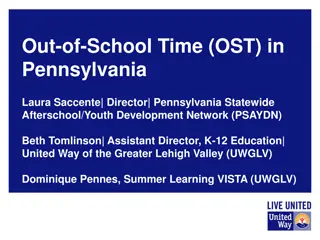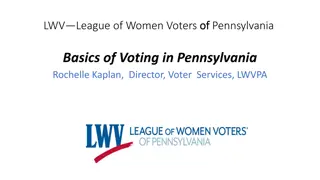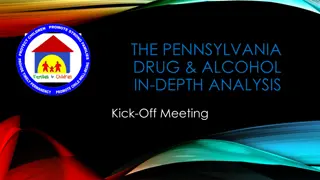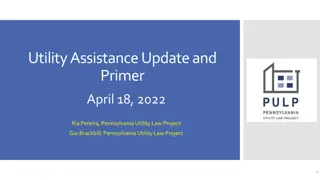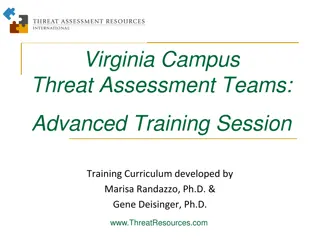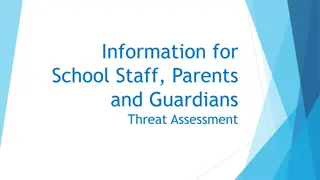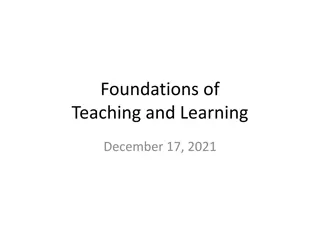Pennsylvania School Threat Assessment Procedures and Guidance
Ongoing concerns about school safety led to legislation in 2019, requiring schools in Pennsylvania to establish threat assessment teams. This presentation provides an overview of the statute, threat levels, team responsibilities, procedures, and resources for school staff, parents, and guardians to ensure a safer school environment.
Download Presentation

Please find below an Image/Link to download the presentation.
The content on the website is provided AS IS for your information and personal use only. It may not be sold, licensed, or shared on other websites without obtaining consent from the author. Download presentation by click this link. If you encounter any issues during the download, it is possible that the publisher has removed the file from their server.
E N D
Presentation Transcript
Information for School Staff, Parents and Guardians Threat Assessment
Introduction There is ongoing concern about the safety and security of the students, staff, and community members who enter school buildings on a daily basis. How do we keep our schools safe?
Introduction In June of 2019, legislation was enacted to assist schools in creating safer environments. One of the acts, Article XIII-E, Threat Assessment was added to the Pennsylvania School Code. The law states that each school entity shall establish at least one threat assessment team. In accordance with the legislation, the School Safety and Security Committee (SSSC), Pennsylvania Commission on Crime and Delinquency (PCCD), and key stakeholders from across PA developed model procedures and guidance materials to help local schools establish and operate threat assessment teams.
Information Guide The information in this presentation is to provide school staff, parents and guardians with: Overview of the Pennsylvania Statute Definition of Threat Levels of Threat Definition of Threat Assessment An Overview of The Threat Assessment Team Members Key Responsibilities Of The Threat Assessment Team Procedures and Guidelines Guidance Documentation
Information Guide The Role of the Team Once a Threat Has Been Made School Staff and Mandated Reporting Strategies that Schools Have in Place to Help Students Recognizing At-risk Behavior Where To Report Observable Behaviors Summary Resources
Overview of Statute: What Do Schools Need To Do? 1. Establish a Threat Assessment Team 2. Facilitate opportunities for team members to be trained on best practices in the threat assessment process 3. Informational Materials a) Students (age appropriate) b) Parents/Guardians c) School Employees
Overview of Statute: What Do Schools Need To Do? 4. Annually present to the school board a report outlining the school s approach to threat assessment. 5. Ensuring Compliance with Federal and State Laws/Regulations Regarding Student Record Confidentiality 6. Communication and Coordination with Other Multidisciplinary Teams a) Student Assistance Program (SAP) Teams b) Special Education Teams (IEPs, 504 Plans, etc.)
Definition of Threat Threat is a communication or behavior that indicates an individual poses a danger to the safety of school staff or students through acts of violence or other behavior that would cause harm to self or others. The threat may be expressed/communicated behaviorally, orally, visually, in writing, electronically, or through any other means. These actions can be considered a threat regardless of whether it is observed by or communicated directly to the target of the threat or observed by a third party, and regardless of whether the target of the threat is aware of the threat.
Levels of Threat One in which the individual/situation does not appear to pose a threat of violence or serious harm. Low One in which the person/situation does not appear to pose a threat of violence, or serious harm at this time; but exhibits behaviors that indicate a continuing intent and potential for future violence or serious harm. Moderate One in which the person/situation appears to pose a threat of violence, exhibiting behaviors that indicate both a continuing intent to harm and efforts to acquire the capacity to carry out the plan; and may also exhibit other concerning behavior that requires intervention. High Exists when the person/situation appears to pose a clear and immediate threat of serious violence toward others and requires containment and action to protect identified or identifiable target(s); and may exhibit other concerning behavior, requiring intervention. Imminent
Defining Threat Assessment Threat assessment is a fact-based process for the assessment of and intervention with students whose behaviors may indicate a threat to the safety of the student, other students, school employees, school facilities, the community, or others. PA Public School Code, Article XIII-E. Threat Assessment. Threat assessment is a prevention strategy. School communities work together to identify student threats before they become acts of violence Schools have systems in place to process information Students receive assistance through early identification
The Threat Assessment Team (TAT) The people on the threat assessment team are appointed by the CPI President and the Joint Operating Committee in consultation with the school safety and security coordinator. The CPI President is to appoint a threat assessment team leader. In addition, when a student is referred to the threat assessment team, the TAT will consult with or engage the participation of someone at CPI who knows the student well, whether that be a teacher, aide, custodian, secretary, or other school staff person.
The Threat Assessment Team The Threat Assessment Team should include: Required Members Individuals with expertise in: Optional Members Other school staff or community resources who can assist with threat assessment process Examples: School security personnel; law enforcement agencies; behavioral health professionals; individuals receiving reports from Safe2Say Something Program; SAP team members; juvenile probation professionals; etc. School health Counselor School administration School safety and security coordinator
Threat Assessment Team: Key Responsibilities Provide materials for students, school employees and parents/guardians. Assess and respond to reports of threat from varying resources; make appropriate determinations, referrals, and notifications. Provide information necessary for annual reporting.
What Will the Team Do, Once a Report Is Made? 1. Once the team receives a report of a potential threat, it is their job to assess and intervene with the student and determine the level of threat. 2. If the student s behavior indicates a threat to the safety of the student, other students, school employees, school facilities, the community or others, the team will immediately notify: a) The CPI President or Vice President of Secondary Education b) The School Resource Officer c) The School Safety and Security Coordinator d) The School Counselor
What Will the Team Do, Once a Report Is Made? (Continued) 3. The Vice President of Secondary Education or designee shall then immediately notify the student s parent or guardian, respond and make appropriate determinations and referrals based on the information available to the team. 4. Following notification of the parent/guardian, the team may refer the students, as appropriate to: a) The Student Assistance Program b) A law enforcement agency c) An evaluation under the Individuals with Disabilities Education Act (IDEA)
What Will the Team Do, Once a Report Is Made? (Continued) d) A student's existing individualized education program (IEP) team established under IDEA and 22 Pa. Code Ch. 14 (relating to special education services and programs) e) An existing team established to implement a student's section 504 service agreement established under section 504 of the Rehabilitation Act of 1973 and 22 Pa. Code Ch. 15 (relating to protected handicapped students) 4. A parent or guardian shall provide consent prior to a team referring a student to: a) A behavioral service provider b) A health care provider c) A county agency
School Staff and Mandated Reporting School employees shall act immediately to address an imminent threat. Imminent threats and emergencies shall be promptly reported to a law enforcement agency. School employees and other mandated reporters shall follow the responsibilities regarding reporting suspected child abuse as required by law. For more information on child abuse recognition and mandated reporting go to: Department of Education: ACT 126 Child Abuse Recognition and Reporting Act; and Department of Human Services: Keep Kids Safe
Strategies That CPI Has in Place Some of the strategies/supports that CPI has in place when a report is made are: Student Assistance Team (SAP) Mental Health Services Addressing Inappropriate Behavior IEP Team (through sending school) Suspension Mentoring Law Enforcement Setting Reasonable Boundaries Other, based on school need
Recognizing At-Risk Behaviors There are observable behaviors which may not be normal and are out-of-character for most students. These behaviors may lead to acts of violence. If the behaviors are noticed early on and dealt with through the strategies that are in place in the school, then appropriate measures can be taken to assist the student before the violence occurs.
Recognizing At-Risk Behaviors Some observable, at-risk behaviors include: Unusual social distancing or isolation of individuals from peers and family members Sullen or depressed behavior from an otherwise friendly and positive person Out of context outbursts of verbal or physical aggression Increased levels of agitation, frustration and anger Confrontational, accusatory or blaming behavior An unusual interest in weapons Fixation on violence as means of addressing a grievance K-12 Threat Assessment in Virginia: A Prevention Overview for School Staff, Parents, and Community Members
Key Findings According to a study done by the U.S. Secret Service and the U.S. Department of Education, incidents of targeted violence at schools are rarely sudden, impulsive acts. They are well-planned. The following are key findings of the study: There is no profile of a student attacker, nor is there a profile for the type of school that has been targeted. Attackers usually had multiple motives, the most common involving a grievance with classmates. Most attackers used firearms, and firearms were most often acquired from the home. Most attackers had experienced psychological, behavioral, or developmental symptoms. Protecting America s Schools: A U.S. Secret Service Analysis of Targeted School Violence, National Threat Assessment Center U.S. Secret Service, U.S, Department of Homeland Security, November 2019
Key Findings Half of the attackers had interests in violent topics. All attackers experienced social stressors involving their relationships with peers and/or romantic partners. Nearly every attacker experienced negative home life factors. Most attackers were victims of bullying, which was often observed by others. Most attackers had a history of school disciplinary actions, and many had prior contact with law enforcement. All attackers exhibited concerning behaviors. Most elicited concern from others, and most communicated their intent to attack. Protecting America s Schools: A U.S. Secret Service Analysis of Targeted School Violence, National Threat Assessment Center U.S. Secret Service, U.S, Department of Homeland Security, November 2019
Reporting In January of 2019, Pennsylvania initiated the Safe2Say Something Anonymous Reporting System, which is run through the Attorney General s Office. It is a 24/7 hotline that allows people to submit tips via phone calls, a secure website or a mobile app. The reporting system allows people to submit secure and anonymous safety concerns to help identify and intervene upon at-risk individuals BEFORE they hurt themselves or others. Individuals can do this by reporting observed threats, behaviors, actions and harassment. Find out more information on the Safe2Say Something website. A downloadable APP for mobile devices is available on Google Play and the App Store.
Reporting Safe2Say Something Call the Safe2Say Something hotline at 1-844-SAF2SAY to report: Assault Abuse (physical, verbal) Bullying or regular intimidation Bragging about an upcoming planned attack Depression, anxiety or loss of self-control Fighting Gun Violence / Violence Harassment Hopelessness, excessive guilt or worthlessness Reckless behavior Social isolation or withdrawal Substance abuse Suicide threats, cutting or other self-harm Theft Threats Weapons (use of and/or discussion about)
Summary It may be possible to prevent future school attacks from occurring through awareness education, following reporting procedures and using the threat assessment team to help students who may have the intent and capacity to commit an act of violence. Not only are schools a place to learn, they are also a place of safety and security for the students, staff and community members who walk through the doors. The school community s awareness and participation in the threat assessment process will help to ensure the safety of the people and buildings.
